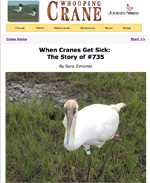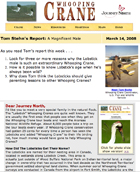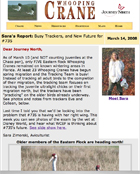Today's Report Includes:
- Highlights: Wintering Cranes and Migrating Cranes >>
- Slideshow Feature: A New Future for Chick #735? >>
- Journal: Why Does the Flock Grow So Slowly? >>
- Coming Soon: We'll Track the Migration >>
-
Links: This Week's Crane Resources >>
The
white-over-green band on the right leg tells us this is crane #420.
Where is she? Find out here. (Scroll
to end)
Photo Colleen Wisinski
|
Read
>> |
Cranes #511 and #316 from the Eastern flock are among older "ultra-cranes" headed north! |
Read
>> |
|
Western Flock: All 266 cranes are still on their Texas wintering grounds. It is usually the last week in March when some of the cranes begin migration, and most Whooping Cranes remain at Aransas NWR into April. Biologist Tom Stehn reminds us: They “know from experience” that conditions are still frozen up north. Tom introduces us to an amazing male whooper this week. Eastern Flock: DAR 40-07 has become the first Hatch Year 2007 chick to head north, but all 17 ultralight-led juveniles are still at their winter pen area in Florida. Amazingly, only five of the experienced older cranes in the flock remain on known wintering grounds. Reports from Georgia and Kentucky say whoopers from the new flock are passing through! |
||
Chick #735 visited Disney World this week, but not for fun. The world-class veterinarians at Disney joined with the WCEP team in trying to figure out why #735 won't fly. Go along to the hospital to see what took place, and see photos of #735 safely back with her flockmates. What's next for this brave bird?
- When Cranes Get Sick: The Story of #735 >>

What's
in the future for chick #735? >>
This week's report gives many facts and clues about why endangered Whooping Crane population grows so slowly. Tom Stehn will discuss it next time, but what are your thoughts after reading features and comments in today's report?
- What are some reasons why the Whooping Crane population grows so slowly?
List your ideas in your Journal. >>
As
reports come in, you'll see the migration progress of both
flocks — ALL
the world's migratory whooping cranes — live
on our MapServer!
|
||
| Click for migration animation >> | Click
for migration animation >> |
|
- Teachers: Getting Started >>
- Photo Journal: How Are Scientists Bringing Back the Cranes? >>
- Get Acquainted: "Meet the Flock" Activities >>
- Slideshow: The Lobstick Male: Crane Extraordinaire >>
- Ask the Expert: Prepare your questions to send March 21-April 4! >>
- Connecting: Tick-Tock: Biological Clock >>
- Video: Watching Walking Whoopers >>
- Whooping Crane Migration Journals (click-and-print) >>
The Next Whooping Crane Migration Update Will Be Posted on March 28, 2008.










